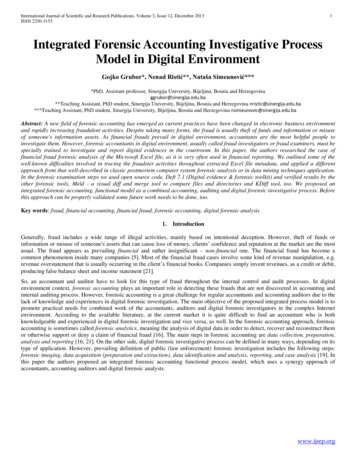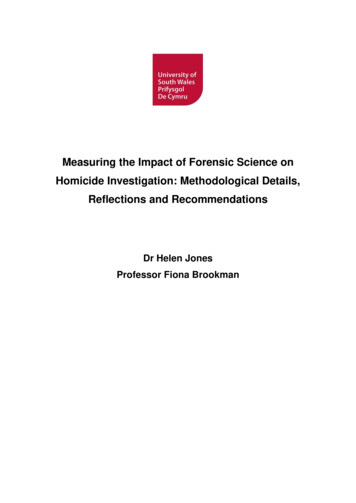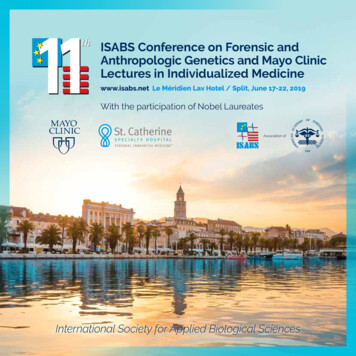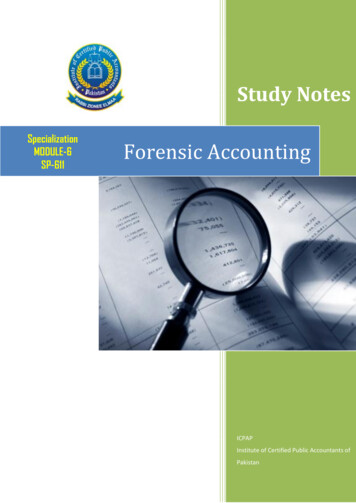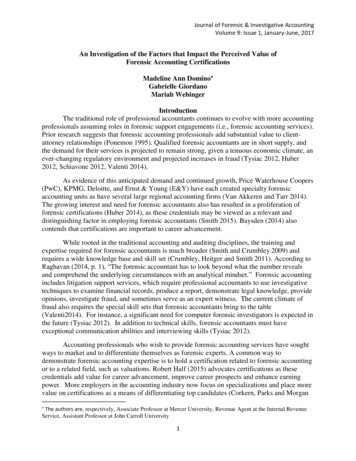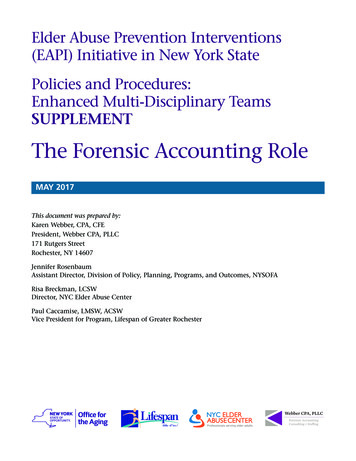
Transcription
Elder Abuse Prevention Interventions(EAPI) Initiative in New York StatePolicies and Procedures:Enhanced Multi-Disciplinary TeamsSUPPLEMENTThe Forensic Accounting RoleMAY 2017This document was prepared by:Karen Webber, CPA, CFEPresident, Webber CPA, PLLC171 Rutgers StreetRochester, NY 14607Jennifer RosenbaumAssistant Director, Division of Policy, Planning, Programs, and Outcomes, NYSOFARisa Breckman, LCSWDirector, NYC Elder Abuse CenterPaul Caccamise, LMSW, ACSWVice President for Program, Lifespan of Greater Rochester
Table of ContentsAcronyms and Terms2Introduction and Background3Defining a “Forensic Accountant”4Education and Professional Standards4Identifying Forensic Accountants to Assist in Elder Financial Exploitation Cases6Cost of Utilizing a Forensic Accountant in Elder Financial Exploitation Cases6Role of Forensic Accountants on the E-MDT for the EAPI Initiative7Education of E-MDT Members Regarding Forensic Accountant Involvement7Process for Accessing Forensic Accounting Services for the EAPI’s E-MDT7Forensic Accountant’s Role During E-MDT Meetings8Case Consultations and the Role of the Forensic Accountant9Case Presentations at E-MDT9Components of a Forensic Accounting Review and Report11Summary and Recommendations13Contact Information14ELDER ABUSE PREVENTION INTERVENTIONS (EAPI) INITIATIVE IN NEW YORK STATE ENHANCED MULTI-DISCIPLINARY TEAMS: THE FORENSIC ACCOUNTING ROLE MAY 2017 PAGE 1
Acronyms and TermsAcronymTermACFEAssociation of Certified Fraud ExaminersACLAdministration for Community LivingAICPAAmerican Institute of Certified Public AccountantsAPSAdult Protective ServicesCFECertified Fraud ExaminerCFFCertified in Financial ForensicsCIACertified Internal AuditorCPACertified Public AccountantDADistrict AttorneyDANYDistrict Attorney of New York (Manhattan)EAPIElder Abuse Prevention Interventions InitiativeE-MDTEnhanced Multi-Disciplinary TeamFAForensic AccountantMDTMulti-Disciplinary TeamNYSOFANew York State Office for the AgingNYCEACNew York City Elder Abuse CenterWCMWeill Cornell MedicineELDER ABUSE PREVENTION INTERVENTIONS (EAPI) INITIATIVE IN NEW YORK STATE ENHANCED MULTI-DISCIPLINARY TEAMS: THE FORENSIC ACCOUNTING ROLE MAY 2017 PAGE 2
Introduction and BackgroundThe New York State Elder Abuse Prevention Interventions (EAPI) grant Initiative was launched inNew York State in 2012 under a grant from the Administration for Community Living (ACL) tothe New York State Office for the Aging (NYSOFA). Project partners convened to implement theintervention in order to prevent and address financial exploitation and elder abuse by bringingtogether entities in each local project site with unique resources and skills to form coordinated,enhanced multi-disciplinary teams (E-MDTs) to provide improved and effective cross-systemscollaboration and specialized responses, resulting in restored safety and security to older adults.The E-MDT model is being implemented in Manhattan by the New York City Elder Abuse Center(NYCEAC), hosted by the Weill Cornell Medicine (WCM), and in seven counties in the FingerLakes Region in upstate New York by Lifespan of Greater Rochester Inc. (Lifespan). The model isbased on an existing multi-disciplinary team (MDT) structure implemented in Brooklyn, NY.E-MDT partner agencies participate from across disciplines, including Adult ProtectiveServices, the aging services network, financial services, law enforcement, legal, social service,victim assistance, health care, mental health, and other agencies and organizations.The EAPI Initiative in New York targets frail adults aged 60 and over residing in Manhattan andthe Finger Lakes region who have a detectable sign of financial exploitation, and also have at leastone of the following characteristics: (1) health problems and/or physical impairments; (2) cognitiveimpairment or dementia; and/or (3) social isolation and inadequate social support, which putsthem at higher risk for becoming victims of abuse. Significant partners in the EAPI Initiativeinclude: Project Director and additional staff from the New York State Office for the Aging (NYSOFA);key partners from the New York State Office of Children and Family Services (OCFS) who overseethe Adult Protective Services (APS) and other adult abuse prevention services and programming;Monroe County Office for the Aging (MCOFA) for project administration; Lifespan, pilot site teamlead for program administration, E-MDT coordination, and implementation of the EAPI Initiativein the Finger Lakes; other local Finger Lakes region human service, protective services, health,mental health, legal, and law enforcement agencies; NYCEAC pilot site team lead and other stafffrom NYCEAC for program administration, E-MDT coordination, and implementation of theEAPI Initiative in Manhattan; New York City APS, and other Manhattan-based human services,protective services, health, mental health, legal, and law enforcement agencies.The primary focus of the EAPI grant program is to address issues of financial exploitation of olderadults. Financial exploitation is a fast growing and complex form of elder abuse. A uniquecomponent of the EAPI implemented in New York is to expand the MDT structure and includeforensic accounting services, and gero-psychiatrists on the E-MDTs to consult and share expertise.The local E-MDT Coordinators engage in case consultation with team members, facilitate E-MDTmeetings, and facilitate active joint investigations and interventions, with an emphasis oninvestigating and stopping potential and existing financial exploitation. This document focuseson the role of the forensic accountant in the EAPI and on the teams.ELDER ABUSE PREVENTION INTERVENTIONS (EAPI) INITIATIVE IN NEW YORK STATE ENHANCED MULTI-DISCIPLINARY TEAMS: THE FORENSIC ACCOUNTING ROLE MAY 2017 PAGE 3
While elder abuse multi-disciplinary teams are emerging in various localities across the country,the E-MDTs developed for this pilot program differ in that they focus on financial exploitation,the teams are facilitated by an E-MDT coordinator, and also are enhanced by the participation ofgeriatric psychiatrists to provide professional expertise to help understand and identify actionsteps associated with issues of capacity (see Roles and Responsibilities of Geriatric Psychiatrists)related to client finances in identified cases. In addition, the Finger Lakes pilot, with countiesrepresenting urban, suburban, and rural locations, utilized the services of a community-basedforensic accountant to support the seven E-MDTs, while the Manhattan (dense urban) team wasstructured to pilot the use of forensic accountants employed by the District Attorney of New York’s(DANY) office to be part of the E-MDT. The concept was to compare the two models to learnabout the ways in which this particular resource could be optimized in different environments tosupport the needs of teams for such services. This component of the Manhattan pilot changedcourse in July 2015, just prior to implementing a no-cost extension phase of the pilot, byterminating the use of the DANY forensic accountants as a formal part of the project, and instead,utilizing a community-based forensic accountant to assist with cases brought to the E-MDT wheresuch analysis was required.This document includes information about forensic accounting; describes the roles of bothcommunity-based and District Attorney (DA)-based forensic accountants; describes how thisprofession adds expertise to multi-disciplinary teams; and provides information about what acommunity-based forensic accountant may be able to provide to a team, as compared to aDA-based forensic accountant, with respect to case reviews, participation, and feedback toE-MDTs, as well as other similarities and differences between community-based and DA-basedforensic accountant services.Defining a “Forensic Accountant”“Forensic accounting” is the practice of accountancy that uses auditing and investigative skills toproduce evidence of financial matters for use in various legal proceedings. Forensic accountantsare employed in many capacities across various industries. A forensic accountant’s experience mayconsist of internal audits, compliance audits, private investigation, litigation support, and businessvaluation, versus traditional financial statement auditing, bookkeeping, or tax work.Education and Professional StandardsEducation often includes a certificate or bachelor’s degree in accounting, and possibly somepost-graduate education in business, accounting, forensic accounting, or even law. Forensicaccountants are usually Certified Public Accountants (CPAs), Certified Fraud Examiners (CFEs),Certified Financial Forensics (CFFs), Certified Internal Auditors (CIAs), or maintain otherdesignations related to their area(s) of expertise.ELDER ABUSE PREVENTION INTERVENTIONS (EAPI) INITIATIVE IN NEW YORK STATE ENHANCED MULTI-DISCIPLINARY TEAMS: THE FORENSIC ACCOUNTING ROLE MAY 2017 PAGE 4
The forensic accountants who consulted under this grant were CPAs and CFEs, credentials thatare guided by professional standards maintained by the American Institute of Certified PublicAccountants (AICPA) and the Association of Certified Fraud Examiners (ACFE), respectively.These professional standards require holders to adhere to a code of ethics or code of professionalconduct in their practice. A code of professional conduct provides principles, rules, andinterpretations governing member responsibilities; including protecting the public interest,maintaining integrity, keeping appropriate policies and procedures, and adequately supervisingemployees’ work. Violation of a code of ethics or code of professional conduct may result insuspension or revocation of the license or certification.Professional standards also require completion of continuing professional education requirementsthat are measured in credit hours. CPAs in New York State must earn 120 credit hours over athree-year period in certain subject areas, and CFEs must earn 20 credit hours per year in certainsubject areas. Fortunately, many subject areas overlap, so forensic accountants who are CPAs andCFEs may earn continuing education credits that meet the requirements for both certifications.Many continuing education courses cover fraud in various forms, but there is a lack of continuingprofessional education courses specific to financial exploitation of the elderly. In fact, none of theforensic accountants consulted under this EAPI Initiative have participated in a credit-bearingcourse specifically related to their work on cases of elder fraud.Most training of forensic accountants in general occurs post-graduation by obtaining certifications,continuing education, and, of course, fraud-related work experience. However, colleges anduniversities have begun incorporating forensic accounting classes, certificate programs, and evengraduate degree programs into their curricula. Still, students graduating with a focus in forensicaccounting are encouraged to obtain CPA licensure before pursuing more forensic accountingspecific certifications. CPA licensure is the most desirable credential for an accountant acting asan expert witness in court proceedings, which any forensic accountant working with an E-MDTmust be prepared to do. Obtaining CPA licensure requires 150 credit hours in undergraduate orgraduate programs related to business and accounting, passing grades on all four parts of theUniform CPA Exam within an 18-month window, and at least one year of work supervised by alicensed CPA. Current CPAs may pursue certifications specific to forensic accounting in an attemptto enter the field, but ability to obtain work depends largely on experience. In Manhattan, forexample, the DA’s office seeks to hire forensic accountants with experience in brokerage firms,among other backgrounds, due to the volume of securities fraud cases they investigate.Identifying Forensic Accountants to Assist in Elder Financial Exploitation CasesBecause the pipeline for forensic accountants is not as clearly defined as the pipeline for traditionalCPAs, it may be difficult for individuals and organizations to locate forensic accountants to meettheir needs. If an individual or organization is not aware of a forensic accountant in the community,one should contact a credentialing organization such as the AICPA or the ACFE. CredentialingELDER ABUSE PREVENTION INTERVENTIONS (EAPI) INITIATIVE IN NEW YORK STATE ENHANCED MULTI-DISCIPLINARY TEAMS: THE FORENSIC ACCOUNTING ROLE MAY 2017 PAGE 5
organizations maintain databases and/or directories of practitioners who have obtained certainforensic accounting-specific certifications, which provide some insight as to the size of the forensicaccounting specialty. The following searches performed are only examples of how to assess thesize of the forensic accounting profession across the states. Such measurement proves to be adifficult task because databases held by separate credentialing organizations do not overlap.An ACFE.com search on August 1, 2016 for CFEs in New York State produced 606 results,but only 111 individuals were listed as practicing public accounting (meaning commercialor non-governmental). Other CFEs may have experience in law enforcement, criminaljustice, banking, etc. Though these 111 CFEs identified by the search may practice publicaccounting, it does not mean that they are licensed CPAs. An AICPA.org search of licensed CPAs could not produce a count of CPAs in a given state,but it could produce a count of CPAs with the CFF designation (Certified in FinancialForensics) in a specific city. For example, on August 1, 2016, the AICPA database showedthat there are 22 CPAs with the CFF designation in New York City, only four in Rochester(Monroe County), and none in Penn Yan (Yates County). Based on this search, it wouldappear that access to CPAs specializing in financial forensics (forensic accounting) acrossNew York State may be increasingly limited outside of urban areas. It is important to note that these directories are populated by user-entered data that mayresult in inaccuracies. For example, an ACFE.com search on August 1, 2016 for CFEs whopractice public accounting in Rochester, New York produces only two results. Some namesof local CFEs were missing from the list, and of the CFEs that were listed, some entries donot show that the local CFE was a CPA as well. Costs of Utilizing a Forensic Accountant in Elder Financial Exploitation CasesOnce forensic accountants have been located, access to their skills depends on adequate funding,either in their capacity as consultants to E-MDTs (in a community-based model), or as employeesin a government agency (such as in a DA-based model).An E-MDT must be prepared to offer a community-based forensic accountant compensation atcompetitive hourly rates. Compensation in the accounting industry is traditionally and largelystill based on an hourly rate for services provided. Specialized accounting service providers, whichinclude forensic accountants, may demand higher rates per hour than general practitioners basedon their experience as expert witnesses. Rates also vary by geographic location and firm size.The trend in the accounting industry lately is for larger firms to merge with or otherwise acquiresmaller entities, especially as many baby boomer partners and owners retire without successionplans. Many large and medium-sized public accounting firms already have special consultingdivisions to handle nontraditional services like forensic accounting, or will have to create them asthey attempt to acquire and retain more diverse client bases. Typically, a larger firm will demandhigher billable rates, even up to 300 per hour. Alternatively, smaller practices present numerousopportunities outside of public accounting for CPAs to offer specialized accounting services for aELDER ABUSE PREVENTION INTERVENTIONS (EAPI) INITIATIVE IN NEW YORK STATE ENHANCED MULTI-DISCIPLINARY TEAMS: THE FORENSIC ACCOUNTING ROLE MAY 2017 PAGE 6
particular niche, such as elder abuse, at more competitive rates. Regardless of firm size, however,inconsistent funding and/or less-than-competitive pay may discourage financial professionalsfrom providing such specialized services to niche areas in need. According to a 2016 report byaccounting and finance talent company Robert Half, average salaries for forensic accountants in acorporate environment range from 74,750 to 116,750.1 Government agencies also must haveadequate funding to hire and retain forensic accountants for work on criminal investigations.Role of Forensic Accountants on the E-MDTsfor the EAPI InitiativeProcess for Accessing Forensic Accountant Services for the EAPI’s E-MDTsThe community-based forensic accountant subcontracted under the EAPI Initiative was KarenWebber, a CPA and CFE in private practice based in Rochester, New York. The DA-based forensicaccountants participating in this EAPI Initiative were supervised by Forensic Accounting andFinancial Analysis Unit Chief Robert Demarest and Deputy Chief Irene Serrapica, both CPAs andCFEs employed at the District Attorney of New York’s Office (New York County, or Manhattan).The DA-based forensic accountants reported to the Chief of the Elder Abuse Unit, Special VictimsBureau/Financial Frauds Bureau in the District Attorney of New York’s Office (DANY).In the EAPI Initiative, elder abuse cases are referred to the E-MDT by team members or otherprofessionals in the community via the E-MDT Coordinator. If a qualifying potential financialexploitation case is brought to the attention of a community-based forensic accountant from anexternal source, the community-based forensic accountant may refer the case to the E-MDTCoordinator for intake by the E-MDT. If an eligible case comes to the attention of a DA-basedforensic accountant, it would be as a result of a pending criminal matter, and such a case wouldnot be referred directly to the E-MDT due to NYS criminal procedure laws regarding grand juryconfidentiality. However, the DA’s office can refer the victim to another participating agency whocould bring the case to the E-MDT, such as when a potential criminal matter is dropped by theDA’s office for insufficient evidence.Education of E-MDT Members Regarding Forensic Accountant InvolvementWhen the Finger Lakes E-MDTs were started, the involvement of the community-based forensicaccountant was briefly explained to members in initial team meetings. When the communitybased forensic accountant joined the Manhattan E-MDT later on in the grant period, a formalpresentation was given via Microsoft PowerPoint to members of the Manhattan team by thecommunity-based forensic accountant. The presentation explained what a community-basedforensic accountant was able to do for the team, in addition to what DANY was doing.1 Robert Half. “2016 Salary Guide”(p18).ELDER ABUSE PREVENTION INTERVENTIONS (EAPI) INITIATIVE IN NEW YORK STATE ENHANCED MULTI-DISCIPLINARY TEAMS: THE FORENSIC ACCOUNTING ROLE MAY 2017 PAGE 7
Forensic Accountant’s Role During E-MDT MeetingsBoth community-based and DA-based forensic accountants attended regularly scheduled E-MDTmeetings in some capacity. In the Finger Lakes, the community-based forensic accountant’sparticipation in E-MDT meetings was based on availability and whether the forensic accountanthad a report to share with the team. In Manhattan, at least one of the DA-based forensicaccountants attended most E-MDT meetings. The meetings were held at the DA’s Office to easethe accessibility for the forensic accountants. The DANY forensic accountants were thus able toattend most meetings.As discussed in the Introduction and Background section of this report, participation by the forensicaccountants under both models changed during the grant period. At the beginning of the grantperiod, the community-based forensic accountant working in the Finger Lakes was employed ata mid-sized accounting firm and time spent attending E-MDT meetings was charged to the grantat agreed upon hourly rates, whether or not the community-based forensic accountant waspresenting a case. This became a budget constraint, and the community-based forensic accountant’sparticipation in regular meetings ceased. The community-based forensic accountant was thenconsulted only when a case required forensic analysis. In the final year of the grant period, thecommunity-based forensic accountant left the mid-sized firm and opened a small practice. Underthe small practice, the community-based forensic accountant agreed to attend as many E-MDTmeetings as possible for the remainder of the grant period at no charge and reduced hourlycompensation rates in order to extend the availability of services into a no-cost extension periodof the grant.The DANY-based forensic accountants attended E-MDT meetings regularly; the meetings werestrategically located at the District Attorney’s Office, which made their participation easier. DANYwas compensated on a flat-fee basis each month for their work with E-MDT and potential E-MDTcases. When the EAPI project began, DANY forensic accountants consulted on potential E-MDTcases. As the project progressed, however, the role of the DANY forensic accountants changedwhen it became clarified that, as employees of DANY, the forensic accountants are prohibitedfrom acting in a consultative capacity, and could only review cases with investigations of activecriminal matters in association with their DANY duties; the forensic accountants could no longerreport back to the E-MDT about their work.When the community-based forensic accountant was contracted to provide services to theManhattan team, she attended Manhattan E-MDT meetings in-person on a quarterly basis, andother meetings via teleconference, based on availability and case requirements. The communitybased forensic accountant was compensated for work with the Manhattan E-MDT in the samemanner as agreed to for the Finger Lakes E-MDTs for the remainder of the grant period.ELDER ABUSE PREVENTION INTERVENTIONS (EAPI) INITIATIVE IN NEW YORK STATE ENHANCED MULTI-DISCIPLINARY TEAMS: THE FORENSIC ACCOUNTING ROLE MAY 2017 PAGE 8
Case Consultations and the Role of the Forensic AccountantTo prepare for an E-MDT meeting involving the FA, the E-MDT Coordinator consulted with acommunity-based forensic accountant for assistance in determining whether or how a new caseshould be efficiently and effectively presented to the E-MDT. Consultation would include a briefreview of the facts of the case, a summary of the documents collected so far, and whether the caseshould be brought to the team before a forensic analysis was completed, or afterward so that theteam may have more evidence for consideration. Due to the contractual relationship between theE-MDT and the community-based forensic accountant, such consultation could occur.Both the community-based forensic accountant and the DANY forensic accountants providedfeedback on the EAPI’s data collection forms.Case Presentations at E-MDT MeetingsDuring E-MDT meetings, the forensic accountant is responsible for: counseling team members onfinancial exploitation cases, including the specific documents caseworker should obtain to developthe case; determining an appropriate timespan for the documents collected; and discerning elementsof exploitation as each case is presented, pointing these elements out to the team during the casediscussion.For example: Mrs. A’s bank statement shows a 500 payment to a credit card company. Has the clientauthorized a credit report to see what other debt might be outstanding? Mr. B’s tax return is showing some dividends from an investment account. Do we know whether thesuspected perpetrator had access to that account too?If the community-based forensic accountant was not present at the meeting, and the teamrecommended or requested a forensic analysis, the E-MDT Coordinator was responsible forinforming the community-based forensic accountant of information provided during the teammeeting and facilitating communication between the forensic accountant and the referring party.If the DANY forensic accountants or representative were not present, the caseworker assigned tothe case was responsible for making the criminal referral to DANY’s Elder Abuse Unit. DANY’s ElderAbuse Unit would then decide whether or not to refer the case to the DANY forensic accountants.Referral of a case to a community-based forensic accountant was usually recommended orrequested by the E-MDT when: Law enforcement needed stronger evidence of financial exploitation to investigate a case A petition for guardianship would be strengthened by a determination of financialmismanagement or exploitation Multiple transfers took place between bank and investment accountsELDER ABUSE PREVENTION INTERVENTIONS (EAPI) INITIATIVE IN NEW YORK STATE ENHANCED MULTI-DISCIPLINARY TEAMS: THE FORENSIC ACCOUNTING ROLE MAY 2017 PAGE 9
Multiple individuals were involved, or suspected to be involved, in the suspected financialexploitation Duration of suspected financial exploitation was unknown Review of a forensic accountant’s report would assist the victim with understanding thenature and scope of the suspected abuse. Referral of a case to DANY was usually recommended or requested by the E-MDT when strongevidence of financial exploitation existed. Strong evidence of financial exploitation typicallyincluded: Stolen assets Unauthorized use of assets or credit Forgery Contractor scams Phone scams.If during the team meeting, the team recommended that a community-based forensic accountantperform a forensic analysis for a particular purpose, this was included in the follow up steps or“action plan” resulting from the meeting. The action plan listed all the team members who wereassigned responsibilities as a result of the E-MDT meeting, the nature of those responsibilities, anda follow-up date for the team to reconvene and assess the results of the plan. If the action planassigned responsibility for a forensic analysis to the forensic accountant, the E-MDT Coordinatorfacilitated the exchange of information between the referring party and the forensic accountantafter the meeting. This included: sharing contact information and any relevant documentationthat existed at that time, such as bank records, intake form, etc. The E-MDT Coordinator wascopied in on all communication between the community-based forensic accountant and referringparty, but not on all communication between DANY and the referring party due to its interpretationof confidentiality requirements under NYS Criminal Procedure Law. Other more rural districtattorneys’ offices in the Finger Lakes permitted the E-MDT Coordinator to be included in suchcommunication, but only until the case was sent to the Grand Jury based on a less strictinterpretation of NYS Criminal Procedure Law.After the community-based forensic accountant completed the analysis, findings were presentedto the E-MDT at a follow-up date designated in the action plan. Results were communicated tothe E-MDT in the form of a handout or a PowerPoint slide deck. A new action plan was set for thecase, as well as a follow up date, and so on until the case was closed.ELDER ABUSE PREVENTION INTERVENTIONS (EAPI) INITIATIVE IN NEW YORK STATE ENHANCED MULTI-DISCIPLINARY TEAMS: THE FORENSIC ACCOUNTING ROLE MAY 2017 PAGE 10
Components of a Forensic Accounting Review and ReportA forensic accountant’s procedures for accepting and reporting on a case that was brought to theE-MDT for forensic accounting review, analysis, and report-back usually differed based on whetherthe forensic accountant was community-based or DANY-based.If forensic accountant involvement was recommended by the E-MDT, the community-based forensicaccountant received pertinent records collected by the case worker or referring party, including thecase intake form prepared by the E-MDT Coordinator, for initial review. If a case warranted criminalinvestigation, the DANY-based forensic accountants requested documents from financial institutionsdirectly via subpoena duces tecum. The community-based forensic accountants cannot request documents from financial institutions directly without client authorization, so for criminal matters, thecommunity-based forensic accountants relied on the district attorney’s office in that jurisdiction torequest the documents. If the community-based forensic accountant were to review records obtainedvia subpoena, the district attorney’s office included a disclosure with its subpoena request, whichstated that a third party (the community-based forensic accountant) could have access to the records.If the disclosure was not completed when the subpoena was issued, the community-based forensicaccountant was prohibited from reviewing the records. Reliance on subpoenas is often necessarybecause even though New York State Social Services Law and Banking Law permit financial institutions to provide financial records to Adult Protective Services, financial institutions are not alwaysresponsive to APS requests for information and not all cases brought to the team are APS-eligible.A review of records consisted of analyzing available account statements; documentation ofregular expenses of the victim(s); Internet and public record search results; and other backgroundinformation gathered on the victim(s), perpetrator(s), relatives or other involved parties. Basedon the initial review, the forensic accountant requested additional documentation deemednecessary to the investigation. In the absence of a criminal investigation, the community-basedforensic accountant had to request the additional documentation from the referring party, whileeither the community-based or the DANY-based forensic accountant had to request records throughlaw enforcement via subpoena, or received documents through APS or other professionals workingon the case who collected
DA-based forensic accountant, with respect to case reviews, participation, and feedback to . CPA licensure is the most desirable credential for an accountant acting as an expert witness in court proceedings, which any forensic accountant working with an E-MDT must be prepared to do. Obtaining CPA licensure requires 150 credit hours in .



